AMD talks PC GPU ray tracing as it looks to the future of Ryzen and Radeon
AMD confirmed Thursday that its next-generation RDNA 2 graphics structure shall be its first to incorporate ray tracing, and that it’s going to advance performance-per-watt enhancements by a further 50 p.c over its present designs. The corporate additionally plans so as to add a compute-specific model of its GPUs, dubbed “CDNA.”
AMD has historically used its monetary analyst conferences to offer perception into its future technique within the CPU and GPU markets, particularly with regard to the PC, cellular, and server areas. It’s the latter market wherein AMD is driving onerous, as enterprise and scientific markets are keen to pay prime greenback for a high-margin Epyc processor—the form of boon monetary analysts like to listen to about.
AMD habitually gives extra perception into its server roadmaps as a manner of constructing credibility with prospects, chief advertising and marketing officer John Taylor stated prematurely of the decision. On this case, nonetheless, the corporate is sharing particulars on key applied sciences that may profit the PC in addition to different segments: a brand new “X3D” packaging expertise that may complement its current “chiplet” designs; a “CDNA” compute-intensive model of its GPUs; and RDNA 2 and three, the evolution of the “Navi” GPU structure that ought to embrace ray tracing.
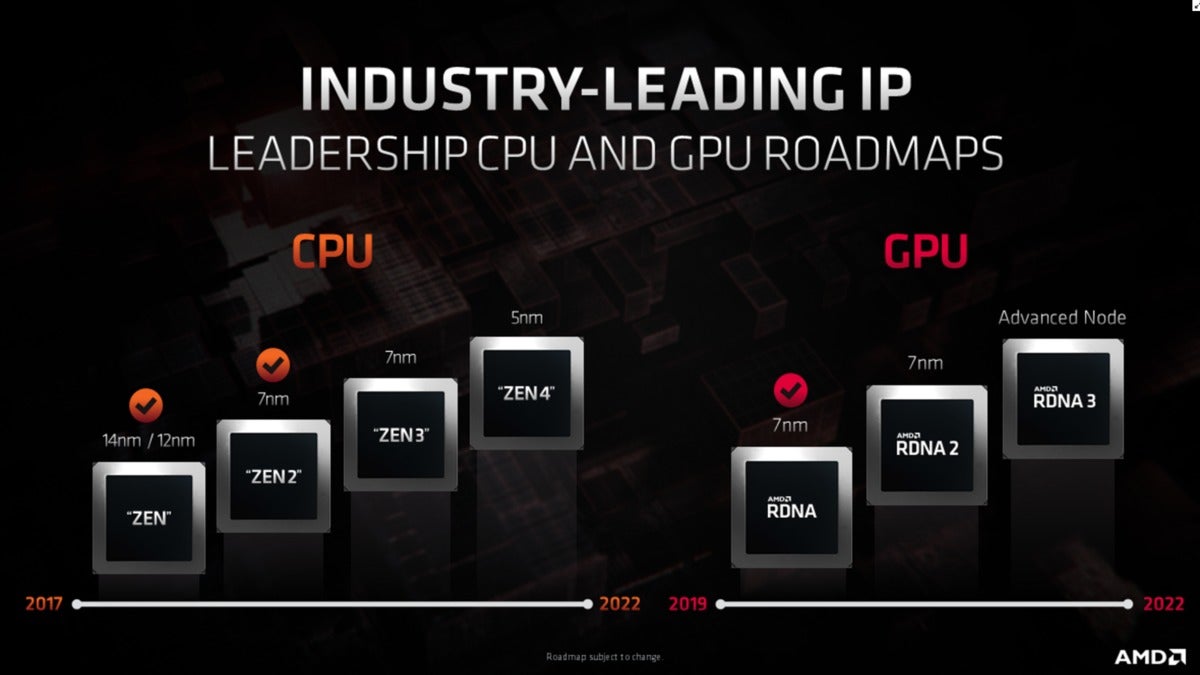 AMD
AMD
AMD teased what it has coming down the pipe by way of CPU and GPU revisions. Notice that AMD’s not saying what the “superior node” means.
Lisa Su, AMD’s chief government officer, started by noting that, before everything, AMD is taking part in to its strengths: excessive efficiency in graphics, CPU, and options that embrace the 2. “That is the basic DNA of our firm,” she stated.
AMD’s Ryzen investments are paying off
Over the following 5 years, AMD will proceed to construct upon its Zen roadmap, its RDNA structure, and 7nm and future course of applied sciences. AMD modified the sport with Ryzen, and it’s paid off, Su stated: Absolutely half of premium desktop PCs use Ryzen, and it’s constantly gained share over the previous few quarters. AMD additionally continues to put money into graphics, solely supplying the Apple Macintosh, and transport over 150 million models within the recreation console enterprise since 2013. However, Su added, AMD remains to be “underrepresented” within the PC market.
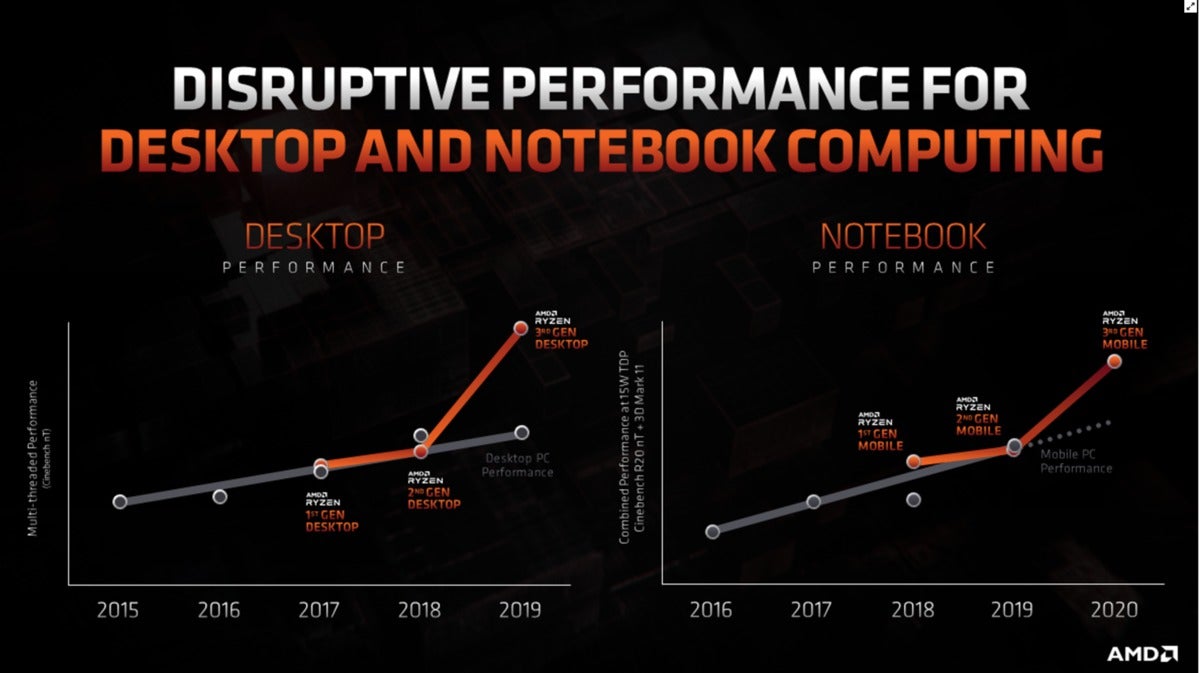 AMD
AMD
AMD’s efficiency took off with its Zen structure.
Now, AMD is on the lookout for new methods to leverage the expertise it already has in home. “We really see extra alternatives to mix our CPU and GPU options,” Su added. AMD has used strategies reminiscent of “chiplets” to enhance the pliability of its processor and graphics design. AMD should construct on these with new packaging and interconnect strategies to maintain pushing efficiency ahead, Su stated.
Su was so assured that the corporate could make it occur that AMD now predicts that it will possibly ship 20-percent compound annual progress in income over the following 4 years—aggressive numbers for a corporation that was struggling only a decade in the past.
What’s subsequent? Zen four and 5nm processors
Based on Mark Papermaster, AMD’s chief technical officer and government vice chairman of expertise and engineering, in every of the product segments AMD serves, there’s a typical thread: unimaginable quantities of compute energy.
 AMD
AMD
AMD’s Zen structure roadmap now extends by way of 2022. Keep in mind, this consists of each Epyc merchandise within the datacenter in addition to the PC.
Papermaster famous that AMD has now switched to a “chiplet” structure, the place numerous merchandise are developed as modular components that may be fitted collectively. A modular strategy didn’t simply change the design of AMD’s merchandise, it modified the corporate tradition—it pressured numerous groups at AMD to work collectively, Papermaster stated. Likewise, it made validation less complicated, permitting AMD engineers to find out whether or not chips have been viable in hours, not days. “That is the brand new regular at AMD,” he stated.
For instance, Papermaster stated that AMD developed a single NUMA area inside its Epyc chips, organizing 7nm CPU cores and connecting them with a 12nm Infinity Cloth I/O.
Papermaster stated that AMD is planning to carry “Zen four” and 5nm processors into the market by 2022, with out specifying which markets could be addressed first. (Taylor indicated that AMD’s rollout technique isn’t anticipated to alter: server first, then desktop, then cellular, with all rolled out by the top of 2022.) Papermaster additionally stated that he expects AMD’s chief competitor, Intel, will clear up its manufacturing issues and speed up its manufacturing expertise.
 AMD
AMD
AMD’s X3D is an extension of its chiplet strategy, combining stacking and a modular strategy.
“Upon getting that degree taking part in area, it’s about how you set these options collectively,” Papermaster stated.
The X3D packaging method shall be used to mix chiplets and 3D stacking, all linked with its Infinity Cloth structure. That Infinity Structure will even enhance, with Third-gen merchandise rolling out by 2022 with as much as Eight-way GPU and coherent connectivity. “What does this imply with these kinds of enhancements? Have a look at machine studying…they demand the sort of connectivity,” Papermaster stated.
 AMD
AMD
AMD’ Infinity Structure will seemingly be largely confined to servers, however not altogether.
Large modifications in AMD’s GPU designs
Maybe probably the most vital information of AMD’s monetary assembly was the truth that AMD could be shifting from a single GPU structure to a number of, domain-specific architectures. Associated and likewise vital would be the long-awaited launch of ray-tracing inside the upcoming RDNA 2 GPU structure.
 AMD
AMD
AMD shall be providing completely different variations of its GPUs for various markets, although it’s not precisely clear how profoundly they’ll differ from each other.
AMD is creating particular variations of the architectures for various markets, reminiscent of the information heart, as a result of it’s turn out to be more and more tough to develop a basic GPU structure as Moore’s Regulation slows down, stated David Wang, senior vice chairman of the Radeon Applied sciences Group at AMD.
AMD’s PC GPU structure is called RDNA, and it’s been the muse of latest Radeon playing cards. Earlier than the top of the yr, nonetheless, AMD will ship RDNA 2 playing cards, which—hurray!—will embrace ray tracing, optimized each for the sport consoles based mostly upon the RDNA 2 structure in addition to PCs. AMD generally referrs to RDNA 2 as Navi 2X, with Navi 3X to observe. (The rumored “Large Navi” codename wasn’t used.) AMD already delivered a 50 p.c performance-per-watt enchancment with its first-generation “Navi” GPU—now it’s aiming to do it once more with the upcoming Navi 2X. That’s loopy!
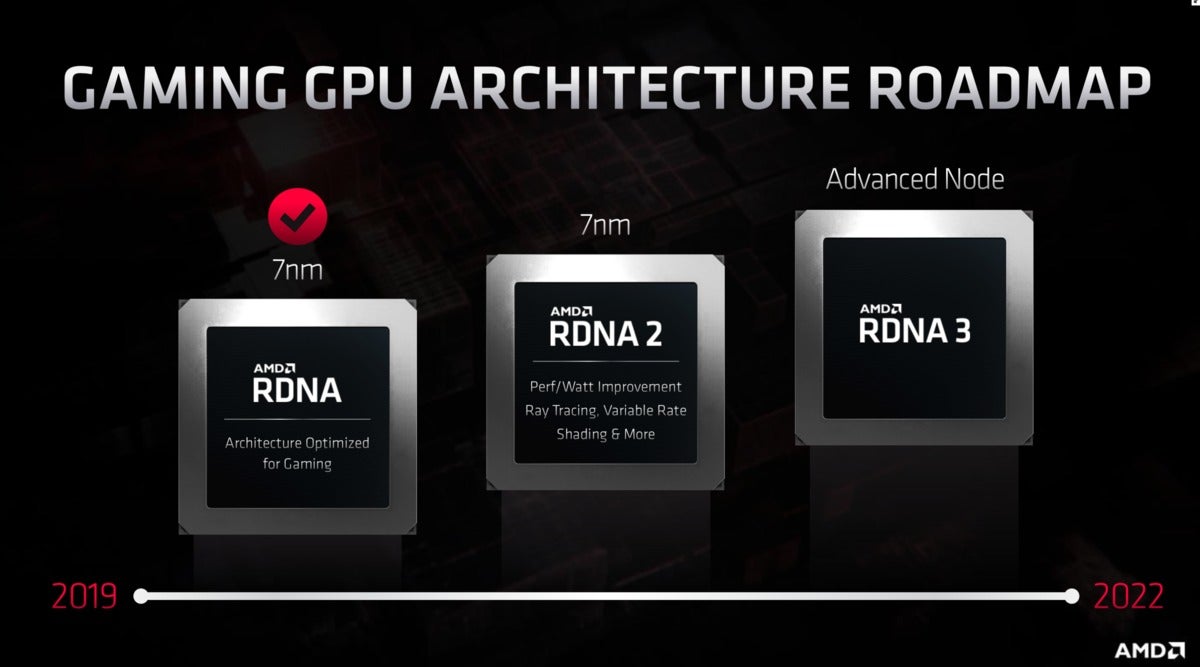 AMD
AMD
AMD is now starting to chart its PC GPU structure, often known as RDNA, out a number of years. And there’s ray tracing!
As for the information heart, AMD’s plan is to design a compute-specific model of RDNA, also called compute DNA, or CDNA. CDNA shall be scalable for multi-GPU for exascale computing and machine studying. AMD additionally confirmed CDNA 2, with the Third-generation AMD Infinity Cloth Structure.
 AMD
AMD
Right here’s what AMD is saying about ray tracing.
“It is a good transfer as datacenter GPUs don’t want lots of the incorporates a client graphics card wants,” stated Patrick Moorhead, principal analyst at Moor Analysis, in an e-mail. “[CDNA] consists of components like show and pixel rendering engines, and ray tracing. This implies AMD can save value by eradicating these components and add extra gates that assist datacenter efficiency like tensor OPS. AMD hadn’t achieved it till at the moment as a result of it couldn’t afford to have two architectures. I imagine AMD can area a excessive efficiency datacenter GPU, however it might want to make investments not less than as a lot in software program to finish the answer.”
What all of it means for the PC
AMD created an “execution machine” in processors, did the identical with GPUs, and mixed the 2 into an APU. Now, there’s a $32 billion PC market ready for what’s subsequent, stated Rick Bergman, government vice chairman of Computing and Graphics for AMD. Earlier than the top of the yr, we’ll know: the fourth-generation Ryzen processor.
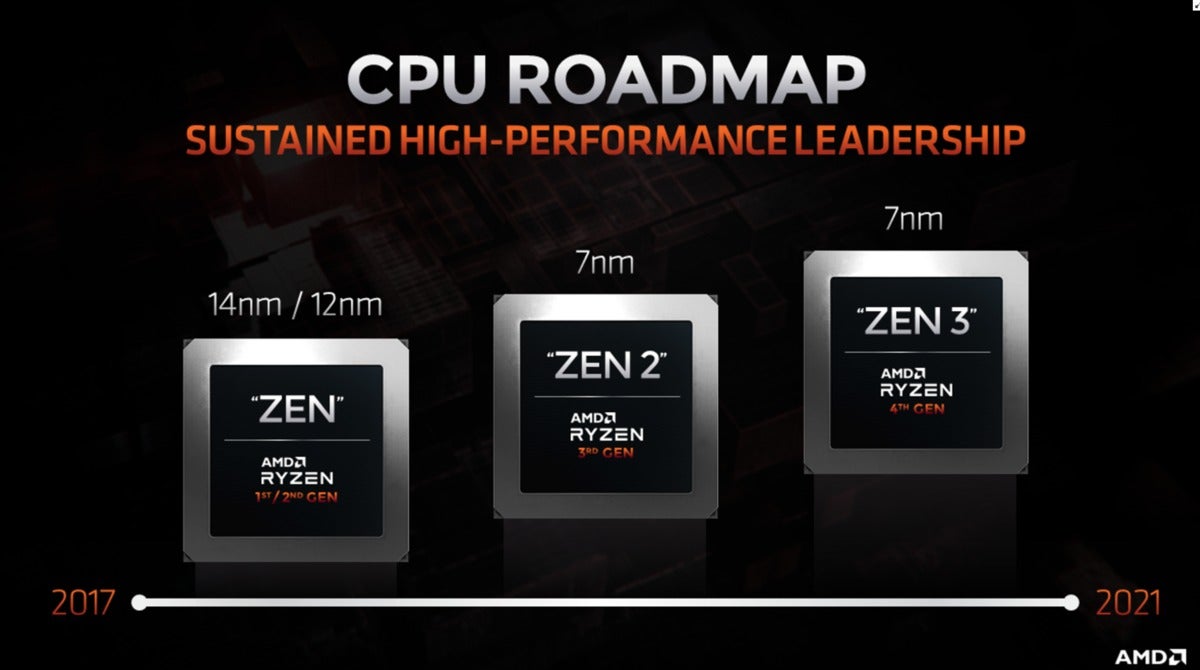 AMD
AMD
AMD’s Zen structure roadmap, although 2022. Zen types the muse of the Ryzen processors.Notice that we’ll be seeing Zen three chips by the top of the yr.
Having secured desktop PC share of about 17 p.c, AMD additionally has its eye skilled on the cellular area, with its cellular Ryzen chips aimed squarely on the pocket book area and particularly industrial PCs. A key expertise is Fashionable Standby, with 5 instances the variety of laptops now supporting the expertise versus the prior era, Bergman stated. AMD can be claiming that variations of the Third-gen cellular Ryzen will ship as much as 18 hours of battery life. (That quantity sometimes varies fairly a bit in the actual world.)
“We wish our prospects to like that have, from the time they open up the field to the lifetime of that have,” Bergman stated.
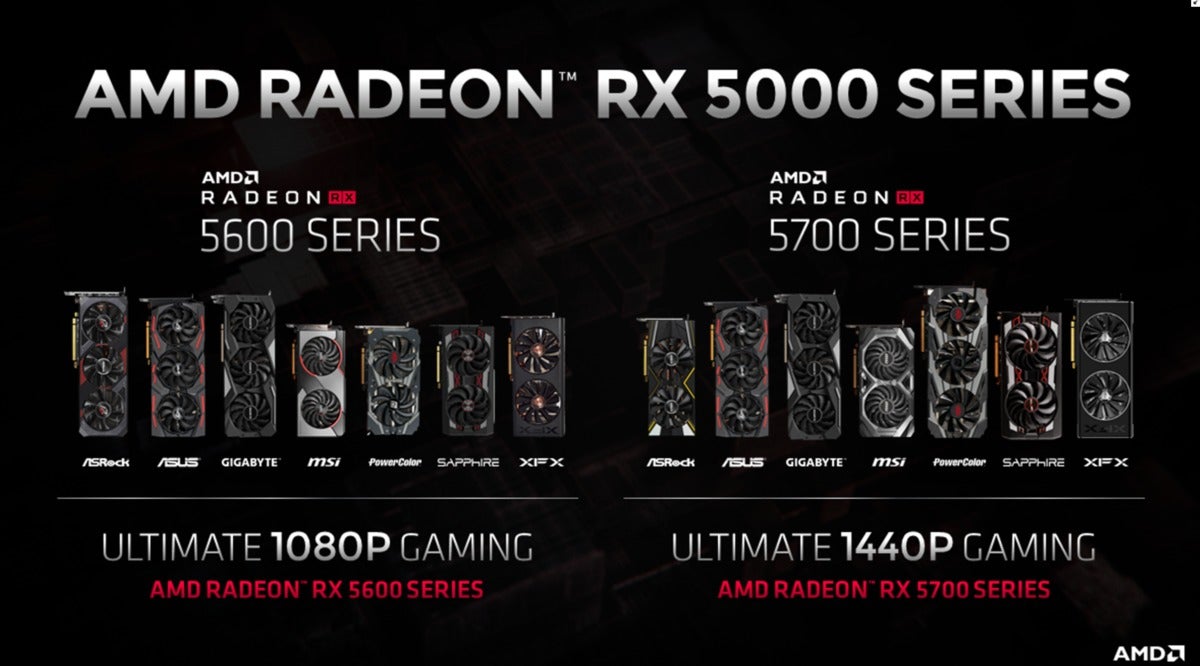 AMD
AMD
AMD’s successful designs in GPU add-in playing cards, too.
Bergman stated that AMD has already secured greater than 70 designs within the industrial PC area, and that’s earlier than Ryzen Cellular or the associated Ryzen Cellular Professional debuted. “We’re anticipating much more,” he stated.
In a shock, Bergman confirmed off a slide indicating that 4th-generation Ryzen chips would start to ship earlier than the top of 2020, just some months after the anticipated ship date of Third-gen cellular Ryzen components. (PCWorld requested for extra specifics about which 4th-generation merchandise would ship first, however AMD didn’t remark additional.) That’s not all: AMD will ship its subsequent the next-generation RDNA 2 playing cards earlier than the top of the yr, “with uncompromised 4K efficiency,” Bergman stated. These would be the first playing cards with based mostly ray tracing and variable-rate shading, he added.
Granted, AMD is revealing scant element about its Zen 2/RDNA 2 playing cards, its next-gen fourth-gen Ryzen processor, or anything. However we all know they’re coming, and AMD will fill within the blanks as we get nearer.
The post AMD talks PC GPU ray tracing as it looks to the future of Ryzen and Radeon appeared first on gariwerd.com.
source https://gariwerd.com/amd-talks-pc-gpu-ray-tracing-as-it-looks-to-the-future-of-ryzen-and-radeon/
Comments
Post a Comment